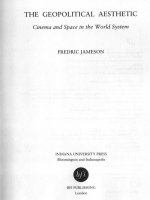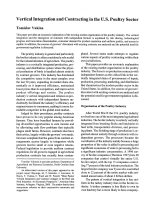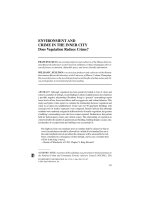farming, hunting, and fishing in the olmec world pptx
Bạn đang xem bản rút gọn của tài liệu. Xem và tải ngay bản đầy đủ của tài liệu tại đây (2.18 MB, 257 trang )
farming, hunting, and fishing
in the olmec world
00-T3504 10/20/05 3:42 PM Page i
The Linda Schele Series in Maya and Pre-Columbian Studies
This series was made possible through the generosity of
William C. Nowlin, Jr., and Bettye H. Nowlin,
the National Endowment for the Humanities,
and various individual donors.
00-T3504 10/20/05 3:42 PM Page ii
farming, hunting,
and fishing in
the olmec world
amber m. vanderwarker
university of texas press
Austin
00-T3504 10/20/05 3:42 PM Page iii
Copyright © 2006 by the University of Texas Press
All rights reserved
Printed in the United States of America
First edition, 2006
Requests for permission to reproduce material from this work should
be sent to:
Permissions
University of Texas Press
P.O. Box 7819
Austin, TX 78713-7819
www.utexas.edu /utpress/about /bpermission.html
The paper used in this book meets the minimum requirements of
ansi /niso z39.48-1992 (r1997) (Permanence of Paper).
library of congress cataloging-in-publication data
VanDerwarker, Amber M.
Farming, hunting, and fishing in the Olmec world / Amber M.
VanDerwarker.— 1st ed.
p. cm. — (The Linda Schele series in Maya and pre-Columbian
studies)
Includes bibliographical references and index.
isbn 0-292-70980-3 (hardcover : alk. paper)
1. Olmecs—Agriculture. 2. Olmecs—Hunting. 3. Olmecs—
Food. 4. Food habits—Mexico—History. 5. Subsistence
economy—Mexico—History. I. Title. II. Series.
f1219.8.o56v36 2006
980Ј.012—dc22
2005008768
ϱ
᭺
00-T3504 10/20/05 3:42 PM Page iv
To Mom and Dad with love and gratitude
To Greg for giving meaning to everything I do
00-T3504 10/20/05 3:42 PM Page v
THIS PAGE INTENTIONALLY LEFT BLANK
contents
acknowledgments ix
Chapter 1 1
agricultural risk and intensification along
mexico’s southern gulf coast: an introduction
Chapter 2 5
agriculture and political complexity
in theoretical perspective
Chapter 3 31
politics and farming in the olmec world
Chapter 4 66
farming, gardening, and tree management:
analysis of the plant data
Chapter 5 116
hunting, fishing, and trapping:
analysis of the animal data
Chapter 6 182
eating plants and animals: stable isotopic
analysis of human, dog, and deer bones
Chapter 7 193
farming, hunting, and fishing in the olmec
world: a model of olmec subsistence economy
notes
205
bibliography 207
index 233
00-T3504 10/20/05 3:42 PM Page vii
THIS PAGE INTENTIONALLY LEFT BLANK
acknowledgments
I would like to recognize those who have helped to bring this project
to fruition, for it is through the help of many different individuals that
the conception and completion of this work was possible. Foremost, I
acknowledge the National Science Foundation (grant no. 9912271) for
funding this project. I would like to express my gratitude to my husband,
Greg Wilson, whose support and encouragement kept me going daily.
Greg helped in so many ways, from proofreading my writing and trouble-
shooting my ideas to calming me down and installing an air-conditioning
unit in my office. I would also like to acknowledge my mentor, Margaret
Scarry, whose guidance and levelheadedness kept me focused. I could not
have asked for a better mentor.
I also acknowledge the other members of my doctoral committee,
Vincas Steponaitis, Philip Arnold, Carole Crumley, Brian Billman, Dale
Hutchinson, and Peter Whitridge. Each brought something different and
important to the mix. Vin’s encouragement and quantitative advice were
pivotal in terms of my data analysis and argument development. I am ever
grateful to Flip, whose support has enabled this project from the very
start. Flip introduced me to Mexico and to the Olmec, assisted in pro-
curing the collections, provided important chronological and regional
information, and was always available to answer questions and listen to
ideas. My conversations with Carole about complexity and global envi-
ronmental change have shaped the ways in which I imagine the past, and
her calm encouragement was greatly appreciated. Thanks to Brian for al-
ways shaking things up and broadening my anthropological perspective
through conversations, seminars, and trips to Peru. Thanks also to Dale,
whose careful comments and close evaluation of this work have made it
that much better, and to Pete for engaging me in many zooarchaeological
conversations.
For the past two years, I have been a member of a cross-disciplinary
writing group, including geographer Cheryl Warren, film theorist Brenda
00-T3504 10/20/05 3:42 PM Page ix
Risch, and political scientist Kerstin Sorensen. Cheryl, Brenda, and Ker-
stin have contributed so much to my writing process—their conversation,
interest, and editing (not to mention coffee and cinnamon rolls) have
helped to crystallize my ideas and clarify my writing. I am grateful to
these amazing and talented women for their support and kindness.
Various friends and colleagues at UNC–Chapel Hill and elsewhere
have had a hand in shaping this project. A series of undergraduate assis-
tants helped with washing, sorting, and data entry. Thanks especially to
Zach George, whose dedication, keen eye, and organizational skills saved
me a great deal of time. Thanks also to Cynthia Armendariz, Sarah Brown,
Abby Schuler, Matthew Edison, Nichole Doub, and Lauren Downs for
their assistance on this project. Thanks to Kandi Detwiler for help with
some preliminary archaeobotanical sorting and to Elizabeth Driscoll for
consulting on some human remains. Seth Murray, Greg Wilson, and Jen-
nifer Ringberg graciously assisted with many of the illustrations. Thanks
also to Mark Rees for theoretical conversations about circumscription.
I have several colleagues who work in Gulf Coastal Mexico that de-
serve recognition for the many ways in which they contributed to this
book. Christopher Pool assisted in procuring the Bezuapan floral and fau-
nal materials, and gave me access to field notes and site maps. He was al-
ways available to answer my numerous questions and discuss ideas and in-
terpretations. Robert Krueger took me on an adventure through the wilds
of the Gulf lowlands to collect modern plant specimens for comparison
—I could not have identified the archaeological plant specimens without
reference to this comparative collection. I am also grateful to Rob and his
wonderful family for hosting me during my stay in Jalapa. Thanks to Va-
lerie McCormack for many conversations about La Joya. I am also grate-
ful to all the people at INAH (Instituto Nacional de Antropología e His-
toria) who helped me access the La Joya and Bezuapan collections.
Mark Schurr of the Fluoride Dating Service at the University of Notre
Dame assisted with conducting the stable carbon and nitrogen isotopic
analysis on the samples used in this work. Laura Cahue prepared and ran
the samples and was very helpful in interpreting the results. Thanks also
to Lee Newsom for consulting with me on some difficult plant specimens.
I could not have completed this project without the support of family
and friends. Thanks to my mom for her unconditional love and friendship,
to my dad for his unswerving faith in me, to my sister for always making
me laugh just when I need it most, and to Hester, Ophelia, and K.B. for
bringing joy into my life. I also thank Bram Tucker, Celeste Gagnon,
x farming, hunting, and fishing in the olmec world
00-T3504 10/20/05 3:42 PM Page x
Chris Rodning, and Jon Marcoux for keeping me going with all the beer
and conversation.
Finally, I would like to acknowledge the contributions of Mary Pohl
and an anonymous reviewer for their careful reading of my manuscript.
Their thoughtful comments and ideas were invaluable in revising this
work for publication.
acknowledgments xi
00-T3504 10/20/05 3:42 PM Page xi
THIS PAGE INTENTIONALLY LEFT BLANK
agricultural risk and
intensification along mexico’s
southern gulf coast:
an introduction
Chapter 1
Chiefdoms developed along the southern Mexican Gulf Coast during the
Early, Middle, Late, and Terminal Formative periods (1400 –1000 bc,
1000– 400 bc, 400 bc–ad 100, and ad 100–300). Scholars interested in
regional political economy for this area have long relied on archaeo-
logical data from three large sites: San Lorenzo, La Venta, and Tres Za-
potes. This focus on large centers to the exclusion of smaller, outlying
villages and hamlets has limited our understanding of regional political
development. Scholars have also relied heavily on assumptions about
regional subsistence economy, for example, that agricultural tribute
was used to fund labor projects and feed the elite. Such assumptions, how-
ever, are based on little actual subsistence data. We can begin to eluci-
date the nature and development of Formative agriculture by shifting our
attention to rural villages and hamlets and to issues of basic subsistence
reconstruction.
Here I consider agricultural intensification and risk in the tropical low-
lands of the Olmec hinterland during a period of political formation. To
address the relationship between the development of agriculture and the
emergence of complex political formations (e.g., chiefdoms and states),
I consider subsistence data from two sites spanning the Formative period:
La Joya and Bezuapan, located in the Sierra de los Tuxtlas approximately
100 km from the lowland Olmec centers.
The Tuxtla region is well suited for exploring this relationship. Settle-
ment data from the region indicate that Early Formative groups were
egalitarian and semi-sedentary (Arnold 2000; McCormack 2002; Santley
et al. 1997). By the Middle Formative period, people had settled into
more permanent villages, maintaining a relatively egalitarian social orga-
nization (Arnold 2000; McCormack 2002; Santley et al. 1997). The sub-
sequent Late and Terminal Formative periods were marked by the emer-
gence of a regional site hierarchy and increasing social differentiation,
though the manifestation of social inequality in the Tuxtlas was not as
pronounced as among lowland Olmec groups (Santley et al. 1997; Stark
01-T3504 10/20/05 3:42 PM Page 1
and Arnold 1997a). Thus, analysis of the available subsistence data makes
it possible to consider farming strategies as they developed alongside
sedentism and chiefdom formation.
In order to understand an agricultural system, we need to understand
the subsistence system as a whole. This requires that we answer basic ques-
tions regarding local and regional subsistence practices. What foods were
people eating? To what extent did people rely on domesticated versus wild
foods and how did this vary through time? Did people narrow or diver-
sify their resource base through time? How varied were subsistence prac-
tices through time and across space? How predictable were plant and an-
imal resources throughout the region? How did volcanic eruptions affect
the distribution and predictability of these resources? Once these basic
questions are answered, we can begin to address more complex questions
linking subsistence to regional politics. What is the nature of the For-
mative subsistence system along the southern Gulf Coast of Mexico? Did
Formative villagers intensify their agricultural systems? If so, what was
the timing of agricultural intensification relative to political development
in the region? What strategies of intensification did they choose and what
were the consequences of these strategies for subsistence economy,
household organization, and local and regional political development?
2 farming, hunting, and fishing in the olmec world
photograph 1.1. The Sierra de los Tuxtlas and Lago Catemaco. (Photograph
courtesy of Philip J. Arnold III.)
01-T3504 10/20/05 3:42 PM Page 2
How did regional environmental catastrophe in the form of volcanic erup-
tions and ashfall affect the way Formative people made a living?
Addressing these questions requires multiple lines of evidence that are
directly relevant to the reconstruction of subsistence economy. I consider
archaeobotanical, zooarchaeological, and stable carbon and nitrogen iso-
topic data from La Joya and Bezuapan. Although these types of subsis-
tence data are rarely considered together in the general literature, they
bear directly on the research questions, as they represent the direct resi-
dues of past subsistence economies. The integration of these three kinds
of subsistence data allows for a fuller understanding of Formative subsis-
tence than would otherwise be possible.
Before I consider these data, it is important to provide the background
necessary for understanding and interpreting them. Chapter 2 presents
some theoretical background on the origins of agriculture. In covering
this monumental topic, I focus on four major issues: the process of early
plant domestication, the connection between incipient agriculture and
early social complexity, the process of agricultural intensification, and
strategies of risk management. Although my case study does not directly
address domestication, many of the arguments put forth to explain the
process of agricultural intensification have their roots in discussions of
the initial process of plant domestication.
Chapter 3 presents an overview of Olmec research as it pertains to
farming and political complexity. The history of the Olmec problem is
particularly relevant because previous studies have set the stage for the
research questions pursued here. Few subsistence studies have been con-
ducted in the region, which has long hampered our understanding of Gulf
Formative agricultural systems—this is one reason why the data pre-
sented here are so crucial. Chapter 3 also provides the environmental and
archaeological background for the Tuxtlas, the region in which the study
sites are located. This chapter constructs a foundation for understanding
subsistence adaptations in the Tuxtlas, a foundation that is necessary for
proper interpretation of the archaeological data.
The second part of the book involves the presentation and analysis of
the data. These are the chapters in which I discuss specific archaeologi-
cal correlates for answering the larger questions posed above. Chapters 4
and 5 consider the archaeobotanical and zooarchaeological assemblages,
respectively. Both chapters consider temporal trends in these data, in ad-
dition to dealing with preservation and recovery biases, field recovery
techniques, field and laboratory sampling, laboratory procedures and
identification, and quantification for the subsistence data. Chapter 6 pre-
agricultural risk and intensification 3
01-T3504 10/20/05 3:42 PM Page 3
sents stable carbon and nitrogen isotopes for human, domestic dog, and
white-tailed deer skeletal specimens. Indeed, it is only through the anal-
ysis of multiple kinds of subsistence data that we can begin to truly un-
derstand prehistoric systems of agriculture. Finally, in Chapter 7 I tie the
analyses together and relate them to the larger research questions stated
above.
4 farming, hunting, and fishing in the olmec world
01-T3504 10/20/05 3:42 PM Page 4
agriculture and
political complexity in
theoretical perspective
Chapter 2
The relationship between agricultural intensification and the emergence
of complex political formations (e.g., chiefdoms and states) has been an
enduring topic in archaeological research. Indeed, this topic continues to
be prevalent in the literature, the number of theories exceeded only by the
questions that remain. Though not all scholars agree about the timing of
agriculture relative to the emergence of chiefdoms and states, we do know
that the adoption and intensification of agriculture varied with the emer-
gence of political complexity in different ways, at different times, and in
different places. Such a complex topic cannot be adequately explained by
a single theoretical framework. This is not to say that any particular case
of incipient agriculture in the context of political development is irrele-
vant to any other. Rather, we are dealing with a set of similar processes
that are structured by specific sets of historical events.
Theories linking agriculture to the emergence of chiefdoms and states
have been more fully developed for arid regions, for which explanations
of environmental and social circumscription are more easily invoked.
Presumably, a limited resource base coupled with population increase re-
sulted in an imbalance between people and their food supply, requiring a
shift to food production. While notions of environmental and social cir-
cumscription have been criticized by some as deterministic (McGuire
1992; Orlove 1980; Paynter 1989; Trigger 1981), they have led archaeol-
ogists to collect baseline data on local and regional ecology and have pro-
vided concepts that can be measured archaeologically, such as popula-
tion growth and carrying capacity (Flannery 1986; Sanders et al. 1979;
Spencer 1982). Circumscription explanations have been less developed
for tropical regions, where resources are more diverse and plentiful—in-
deed, this abundance of resources in tropical environments makes it diffi-
cult to envision an imbalance between people and food. For this reason,
the notion of circumscription may be less useful for understanding the
range of processes at work in tropical environments.
02-T3504 10/20/05 3:42 PM Page 5
Determining the relationship between population growth and agricul-
tural intensification is key to understanding the emergence of chiefdoms
and states. However, before we can hope to understand this relationship,
we must first explore the processes of intensification. Why did people in-
tensify agriculture and what were the consequences of this process? Un-
fortunately, scholars have placed more emphasis on relating the issue of
intensification to political and environmental change than to elucidat-
ing the concept of intensification itself. It is important that we infer agri-
cultural intensification directly from archaeological data on agriculture,
not from population estimates or changes in political organization. It is
not until we know the organization of an agricultural system that we can
understand its relationship to the larger political context. Thus, we must
begin by answering the smaller questions in order to lay the foundation
for answering the larger ones. What are the strategies of agricultural in-
tensification and how do they vary relative to different environments and
different crops? How do we identify these strategies archaeologically?
What risks were involved in the shift to a farming economy, and how did
people prevent and manage these risks? It is also important to understand
that the shift from foraging to farming did not necessarily mean that
people stopped collecting wild plants or hunting game. Rather, people of-
ten combined these strategies into a mixed subsistence economy (Tucker
2000; Kent 1989). Thus, when we consider agricultural intensification,
we need to ask not only how and why it may have affected farming prac-
tices, but also how and why it may have affected foraging practices.
In order to address these questions, I first provide a framework for ex-
ploring issues of agricultural intensification and risk. Theories about the
origins of agriculture provide a necessary starting point, since plant do-
mestication and incipient agriculture were both well under way before
the formation of complex societies, at least in Mesoamerica. Next, I con-
sider how agriculture has been linked theoretically to the rise and main-
tenance of chiefdoms and states. Finally, I deal specifically with the pro-
cesses of intensification in terms of strategies of land use and labor, and
consider the role of risk management in farming economies.
the origins of plant domestication
and agriculture
Some of the debate surrounding the origins of agriculture stems from
the problematic use of terms (see also B. D. Smith 2001). As Blake et al.
(1992) point out, we must differentiate between the origin and the spread
6 farming, hunting, and fishing in the olmec world
02-T3504 10/20/05 3:42 PM Page 6
of agriculture. More importantly, we must be explicit in defining our
terms and sticking to them. Too often “domestication” and “agriculture”
have been used loosely and sometimes interchangeably—a serious prob-
lem, considering the very different processes represented by these two
terms. Thus, it seems necessary to begin with some basic definitions of
terms. These definitions should be considered preliminary and are in-
tended as a point of departure for theoretical considerations of early agri-
culture. My aim is to avoid the confusion that has become an intrinsic
aspect of this debate.
Following Price and Gebauer (1995), domestication is defined here as
a biological process that involves genetic changes in plants and animals
as they become increasingly dependent on human intervention for their
survival and reproductive success (see also Gebauer and Price 1992). I fo-
cus specifically on plant domestication, since animal domestication is not
particularly relevant to the Olmec case. Though defined as a biological
process, domestication is clearly dependent on humans through activi-
ties such as seed dispersal, tending, tilling, and transplanting (Ford 1985).
These activities can be subsumed under the term “cultivation,” defined
here as a technological process that involves the intentional preparation,
sowing, harvest, and storage of plants (Price and Gebauer 1995). Culti-
vation can occur on several different scales, from a small home garden to
large-scale, intensive monocropping. While cultivation does not necessi-
tate agriculture, agriculture does require cultivation.
Different from the biological process of domestication and the tech-
nological process of cultivation, agriculture is a decidedly social phenom-
enon.
1
Price and Gebauer (1995:6) define agriculture as
a commitment [by humans to the] relationship with plants and/or ani-
mals. It ultimately involves changes in the human use of the earth and
in the structure and organization of human society—the widespread
use of ceramic containers, the extensive clearing of the forest, the cul-
tivation of hard-shelled cereals that can be stored for long periods
of time, the invention and adoption of new technologies for farming
and/or herding, more villages and more people, and an increased pace
along the path to more complex social and political organization.
Agriculture, then, characterizes a way of life that is an outcome of the do-
mestication process coupled with fundamental changes in social structure.
Given this broad definition of agriculture, when can a society be con-
sidered agricultural? Do people have to completely rely on domesticated
foods for their survival? What about mixed subsistence strategies that
agriculture and political complexity 7
02-T3504 10/20/05 3:42 PM Page 7
combine foraging with farming? Can extensive slash-and-burn farming
be considered agriculture? Different researchers would respond very dif-
ferently to these questions. Most would agree, however, that “becoming
agricultural” is a process that occurs along a continuum. Because “being
agricultural” means different things to different people, the practical use
of this term is somewhat problematic—“Group A practices agriculture”
does not tell us as much as “Group A combines extensive slash-and-burn
farming with hunting game” or “Group A intensively cultivates grains us-
ing irrigation and raised-field technology for the bulk of their subsis-
tence.” Thus, I limit my use of the term “agriculture” to broader, more
abstract theoretical discussions. Whenever I refer to case studies or to my
data and interpretations, I use more specific terminology (e.g., exten-
sive/intensive, foraging/gardening/farming).
Given these working definitions, it should be clear that the process of
plant domestication began long before people “became agricultural.”
While scholars may disagree over the specifics of plant domestication,
most would probably agree about the basic processes underlying the ori-
gins of domestication in the New World. The initial genetic manipulation
of plants by humans is thought to have been accidental and unconscious,
at least in the New World (Ford 1985; Galinat 1985; Pearsall 1995a;
Rindos 1980; but see Layton et al. 1991; B. D. Smith 1998). For example,
Galinat (1985:255) sees the process of maize domestication as an “unin-
tentional by-product” of gathering teosinte. Teosinte would have been
gathered and brought back to campsites, where it would have established
itself in trash middens, places ideally suited for weedy followers. The
simple tending of these plants after they had established themselves would
thus have been the first step in cultivation.
Flannery (1973:307) argues that staple domesticates (seed crops) be-
gan as “third-choice foods.” These species would have required more la-
bor in terms of harvest and preparation than gathered fruits and greens.
Nevertheless, these seed crops had significant characteristics not shared
by other foraged foods—they were annuals that yielded high returns,
tolerated a wide range of disturbed habitats, stored easily, and were ge-
netically malleable (Flannery 1973). Through time, these seed crops “re-
sponded with favorable genetic changes” that made them suitable as agri-
cultural staples (Flannery 1973:307).
Rindos (1980) explains the beginnings of domestication as a coevolu-
tionary process involving incidental dispersal and protection of plants
by people. More specifically, he defines domestication as the result of
predator-prey relationships characterized by mutualism in which both
8 farming, hunting, and fishing in the olmec world
02-T3504 10/20/05 3:42 PM Page 8
humans and plants/animals benefited (see also Pearsall 1995a; Watson
1995). In the process of gathering and eating plant foods, humans acted
as agents of dispersal, thereby ensuring the reproductive success of those
plant species. This process led to genetic changes in the plants that made
them more desirable to and dependent upon humans.
It is in the culmination of this process of domestication—i.e., the
adoption of domesticates as dietary staples—that the debate lies. Gener-
ally, there are three theoretical frameworks for understanding the shift to
a reliance on cultigens: coevolutionary, environmental, and sociopoliti-
cal. The coevolutionary model picks up the second part of Rindos’ model.
Rindos’ explanation for the origins of agriculture is essentially a continu-
ation of his explanation of the domestication process—plant /human in-
teractions led to the abundance of domesticates, and hence the cultivation
of domesticates. Eventually, a few domesticates became primary staples.
This reliance on a few domesticates would have resulted in subsistence in-
stability, which would have then necessitated intensification of those spe-
cies in order to produce enough food to maintain the subsistence system.
Thus, agriculture is simply the outcome of domestication.
One of the main problems with Rindos’ model is that the process by
which domestication leads to agriculture is simply described and left un-
explained. If we consider the definition of agriculture given above, then
we must ask what role people play in Rindos’ model. He states that human
intent, though certainly present, is unimportant for understanding the
processes involved in the origins of agriculture (see also Watson 1995).
“Thus, intentionality as the ‘recognition of the long-term effects of be-
havior’ must be abandoned in our study of the origins of agriculture. To
deny intentionality, of course, is to deny consciousness; I am not claiming
that people are incapable of reflection but only that reflection and con-
sciousness are incapable of causing the initiation of cultural changes such
as agriculture” (Rindos 1984:98). In dismissing human intention, Rindos
is missing a crucial step—that human intention and reflection lead to hu-
man action, and it is human action and decision-making that lead to so-
cial change. Thus, if we choose to view agriculture as a social phenome-
non involving an entire suite of changes in the way people organized their
social and physical worlds, then explaining agriculture as a natural out-
come of domestication is inadequate.
Winterhalder and Goland (1997:127; see also Winterhalder 1990)
support Rindos’ model to the extent that domestication “developed
through processes of co-evolution between human beings and the re-
sources they exploited,” but they criticize the exclusion of individual
agriculture and political complexity 9
02-T3504 10/20/05 3:42 PM Page 9
decision-makers from the process. Instead, Winterhalder and Goland
propose an evolutionary ecology model that incorporates human inten-
tionality. Specifically, they are interested in how foraging decisions about
resource selection brought foragers “into contact with potential domes-
ticates and how this might affect population density and subsistence”
(Winterhalder and Goland 1997:123). To this end, they argue that ex-
planations for the transition from foraging to farming should begin with
a consideration of “immediate” variables (e.g., changes in resource abun-
dance and prey selection) before invoking broader, systemic variables
(e.g., changes in climate). In other words, we need to understand the de-
cisions that people made with respect to domestication, and why they
made them, if we are to understand the shift to agricultural production.
Winterhalder (1990) and Winterhalder and Goland (1997) explain
the transition to farming in terms of changing strategies of risk avoidance.
In a foraging economy, people avoid risk by pooling food between house-
holds. To deal with the unpredictability in yields for any specific foraging
location (an individual can only forage in one place at a time) and because
the interval between foraging episodes is relatively short (lack of long-
term storage and food preservation), foragers probably pooled resources
across households (Winterhalder 1990:67–69; Winterhalder and Go-
land 1997:140 –141). In a farming economy, people may avoid risk by
planting several dispersed fields. To deal with the unpredictability in har-
vest yields related to plot location and the possibility of crop failure, a
farmer can maintain crops in several different locations at once (Winter-
halder 1990:67–69; Winterhalder and Goland 1997:140–141). Thus,
unlike foragers who buffer against risk at the community level, farmers
can buffer against risk at the household level by combining field disper-
sion with grain storage. The transition from foraging to farming there-
fore involved a significant social shift in risk-avoidance strategies from
inter- to intra-household sharing. While this model explains how the
transition from foraging to farming might have occurred, it does not ex-
plain why.
Hence it is necessary to entertain other explanations for the transition
to farming. The earliest models for interpreting the origins of domesti-
cation were driven by environmental variables. Childe’s (1956) Oasis Hy-
pothesis posited climatic shifts toward drier conditions in the Levant.
He argued that farming began on the plains of Mesopotamia during a dry
period in which vegetation clustered around a limited set of water sources.
As a result, humans and wild plants and animals congregated in these
oases, which led to competition for resources. Childe (1956) thus sees the
10 farming, hunting, and fishing in the olmec world
02-T3504 10/20/05 3:42 PM Page 10
domestication of plants and animals by humans as the solution to an en-
vironmental dilemma. Although Childe’s Oasis Hypothesis was later con-
tested by Braidwood (1960), more recent evidence indicates that Childe’s
original thesis was essentially correct (McCorriston and Hole 1991). Mc-
Corriston and Hole (1991:59) argue that an increase in summer aridity
coupled with shrinking lakes led to seasonal shortages in critical re-
sources. Humans adapted to these seasonal shortages by becoming seden-
tary, storing foods, and intensifying their exploitation of local resources
(McCorriston and Hole 1991:59). The latter strategy eventually led to
local depletion of wild resources, and thus people turned to plant tending
as a solution to their food problems (McCorriston and Hole 1991).
Perhaps the most enduring model deals with population pressure as
the causal agent in this transition (Binford 1968; Cohen 1977; Redding
1988; Watson 1995). This model is similar to Childe’s Oasis Hypothesis
in that it views domestication as a solution to a food shortage problem.
The population pressure model explains the shift to domestication, how-
ever, not in terms of climatic change, but as a result of an imbalance be-
tween regional carrying capacity and population levels. Cohen (1977:50)
defines population pressure as “an imbalance between a population, its
choice of foods, and its work standards, which forces the population ei-
ther to change its eating habits or to work harder (or which, if no adjust-
ment is made, can lead to the exhaustion of certain resources).” Once
population levels grew to the extent that food resources became stressed,
foragers could have chosen between several different strategies. They
could have chosen to do nothing, at which point people may have died
from starvation, causing population levels to decline below the regional
carrying capacity (Cohen 1977; Redding 1988). They could have emi-
grated to a new region, unless all of the neighboring regions were already
inhabited (e.g., social circumscription) (Cohen 1977; Redding 1988). Or
they could have turned to plant cultivation as a means of producing more
food to feed to their growing population (Binford 1968; Cohen 1977;
Redding 1988). This shift to a reliance on managed resources would have
gradually increased until people were dependent on farming to meet the
bulk of their subsistence needs.
The population pressure model differs from Rindos’ coevolutionary
framework by providing tangible expectations that allow us to understand
some of the specifics of the origins of agriculture. Based on the model, we
can expect that a reliance on farming would be preceded by an increase in
population and would occur first in resource-marginal areas. Moreover,
the first domesticates should be species with the potential to be staple
agriculture and political complexity 11
02-T3504 10/20/05 3:42 PM Page 11
foods. Once people have begun cultivating domesticates, the relative con-
tribution of these staples should gradually increase.
Agricultural origins models that rely on environmentally driven vari-
ables such as climatic change and population pressure have been criticized
as being too functionalist (see Hayden 1992). As a result, some scholars
have turned to social models to explain the transition from foraging to
farming. Bender (1978, 1990) and Hayden (1990, 1992, 1995) see farm-
ing as a way for aspiring elites to create a surplus that can be used to fund
status-related events. For Hayden, it is not resource stress and population
pressure that are key issues but a breach in the ethic of resource sharing,
specifically food resources.
2
Beginning with the assumption that people
are basically self-interested, Hayden asserts that foraging groups will
not produce enough food to create a surplus while an ethic of sharing is
still in place. Thus, he argues that domestication likely originated first in
“areas of plenty” (as opposed to marginal environments) where an ethic
of food sharing would have been less developed to begin with (Hayden
1992:12–13).
According to Hayden, domestication would have developed in the
context of competitive feasting, wherein individuals hosted social events
as a strategy for gaining status.
3
Part of this status quest would have in-
volved the display of exotic goods and foods. It is within this context that
the first domesticated foods would have become incorporated into the
diet, not as staples but as delicacies imbued with prestige (Hayden 1992,
1995). Thus, it is expected that domesticates would have been relatively
minor additions to the diet for a long time. While this model is intrigu-
ing, it suffers from a lack of supporting evidence. Archaeological data
from multiple regions worldwide have revealed that the first domesticates
were not delicacies, as Hayden suggests, but instead were the antecedents
to staple crops (B. D. Smith 1998:209). Moreover, most of the archaeo-
logical evidence of domestication in Mesoamerica points to a protracted
period of domestication and incipient cultivation prior to the emergence
of chiefs (Flannery 1986; B. D. Smith 1998). Guila Naquitz, a cave site
in Oaxaca, is perhaps the best example in that it provides evidence of early
plant domestication that dates approximately 5,000 years before the es-
tablishment of the first agricultural villages in the region (Flannery 1986;
B. D. Smith 1998).
Environmental and social models are not necessarily at odds with
each other. Indeed, people may have begun farming as a result of both
environmental and social causes. For example, population pressure might
simply have been an additional impetus for turning feasting foods into
12 farming, hunting, and fishing in the olmec world
02-T3504 10/20/05 3:42 PM Page 12









